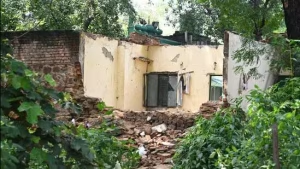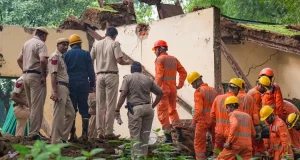New Delhi – A devastating Wall Collapse Near Humayun Tomb has claimed seven precious lives and triggered a comprehensive investigation into structural negligence and safety violations. The tragic incident occurred at Patte Shah Dargah in southeast Delhi, where heavy monsoon rains and waterlogging allegedly contributed to the catastrophic failure of centuries-old structures.
Delhi Police have launched an intensive investigation into the Wall Collapse Near Humayun Tomb, focusing on determining the exact sequence of events that led to this preventable tragedy. The incident has raised serious questions about heritage structure maintenance, safety protocols, and administrative oversight in historically sensitive areas.
Digital Evidence Collection and Investigation Strategy

Law enforcement officials have strategically seized digital video recording systems from the neighborhood surrounding the Wall Collapse Near Humayun Tomb site. These DVR systems contain crucial CCTV footage that investigators believe will help reconstruct the precise timeline of events leading to the structural failure.
The comprehensive evidence collection approach for the Wall Collapse Near Humayun Tomb investigation includes analyzing multiple camera angles from surrounding areas to understand environmental conditions, structural warning signs, and human activity patterns before the collapse. This technological evidence will prove vital in establishing liability and preventing similar tragedies.
Police investigators are methodically examining whether the weak structural condition of the dargah and prolonged absence of renovation work directly contributed to the Wall Collapse Near Humayun Tomb. This investigation approach demonstrates commitment to uncovering systemic failures that may have made this disaster inevitable.
Tragic Human Cost and Victim Identification
The Wall Collapse Near Humayun Tomb incident trapped eleven people beneath debris when the roof and walls of two rooms at Patte Shah Dargah collapsed during Friday’s heavy rainfall. Seven individuals lost their lives in this preventable tragedy, while others sustained serious injuries requiring immediate medical attention.
Victims of the Wall Collapse Near Humayun Tomb have been identified as Swaroop Chand (79 years old), Mohammad Moin (37), Anita Saini (50), Mohammad Arif, Mohammad Abid, Meena Arora, and her daughter Monushca. Each victim represents a family devastated by this structural failure that could have been prevented through proper maintenance and safety measures.
Also Read: Massive Protest Against SC Dogs Order Intensifies at Delhi’s Ramlila Maidan
Among the most heartbreaking aspects of the Wall Collapse Near Humayun Tomb tragedy is the story of Meena Arora and her 23-year-old daughter Monushca, who sought shelter from heavy rain inside the dargah. This mother-daughter pair from Vasant Kunj became victims of circumstances beyond their control, highlighting how innocent people suffered due to structural negligence.
Legal Framework and Criminal Charges


Deputy Commissioner of Police (Southeast) Hemant Tiwari confirmed that an FIR has been filed regarding the Wall Collapse Near Humayun Tomb under multiple sections of the Bharatiya Nyaya Sanhita. The charges include Section 290 (negligent act during demolition), Section 125 (endangering life due to negligent act), and Section 106 (causing death by negligence).
These serious criminal charges related to the Wall Collapse Near Humayun Tomb target unidentified persons whose negligence may have contributed to the structural failure. The legal framework demonstrates authorities’ commitment to holding responsible parties accountable for preventable deaths caused by inadequate maintenance and safety oversight.
The FIR filing represents the first step in a comprehensive legal process that could result in significant consequences for those found responsible for the Wall Collapse Near Humayun Tomb tragedy.
Structural Deterioration and Maintenance Negligence

Eyewitness accounts and local testimonies regarding the Wall Collapse Near Humayun Tomb reveal shocking details about long-term structural deterioration. Investigation officers have documented allegations that the dargah rooms remained without renovation for approximately 40-50 years, creating dangerous conditions that culminated in Friday’s tragedy.
The investigation into Wall Collapse Near Humayun Tomb has revealed that walls contained visible cracks while the structure’s foundation had weakened due to persistent waterlogging and soil erosion. These conditions created a perfect storm for structural failure during heavy monsoon conditions.
While the shrine itself dates back centuries, police investigations indicate that the collapsed rooms were constructed 50-60 years ago without adequate maintenance or structural reinforcement over subsequent decades.
Administrative Jurisdiction and Responsibility Disputes


The Wall Collapse Near Humayun Tomb investigation has exposed confusing jurisdictional disputes between different administrative authorities. Municipal Corporation of Delhi officials claimed the dargah falls under Archaeological Survey of India oversight, while ASI denied this responsibility, creating administrative confusion that may have contributed to maintenance neglect.
Investigators examining the Wall Collapse Near Humayun Tomb are actively seeking records from both MCD and ASI to establish clear maintenance responsibilities and identify potential negligence by responsible authorities. This jurisdictional confusion highlights systemic problems in heritage structure management.
Personal Tragedy and Family Impact
The human story behind the Wall Collapse Near Humayun Tomb includes devastating personal accounts from grieving families. Saurabh Khanna, son-in-law of victim Meena Arora, described how his mother-in-law regularly visited nearby religious sites every Friday, accompanied by her daughter on Independence Day due to the holiday schedule.
The family’s account of the Wall Collapse Near Humayun Tomb reveals how innocent religious observance became a death trap due to structural negligence. Meena and Monushca sought shelter from heavy rain, never anticipating that their refuge would become their final resting place.
This tragic aspect of the Wall Collapse Near Humayun Tomb underscores how maintenance failures affect innocent people whose only mistake was seeking shelter during adverse weather conditions, highlighting the broader social responsibility for maintaining safe public structures.

